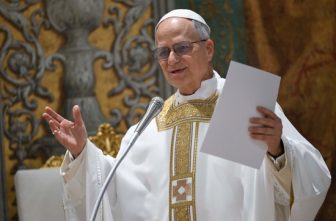Editor’s note: This is the first column of “The Local Church,” a new occasional series that features reflections from leaders in the Archdiocese of St. Paul and Minneapolis. Interested in contributing? E-mail your column idea to CatholicSpirit@archspm.org.
Since the early 20th century, Catholics in the United States have generously sent and supported missionaries all over the world. These efforts made it possible for God’s word to be seen and heard. This support allowed the sacraments to be celebrated in some of the most remote places on earth. The faith was handed on to new generations of seekers. We have played a vital role in training future leaders of the Church in mission areas.
What might not be as well known is that this same generosity of spirit is needed here at home. It may be surprising to know that the Church is poorly established in many parts of our country, especially in Appalachia, Alaska, the South and Southwest along the Mexican border, the Rocky Mountain states, and the U.S. territories in the Caribbean and Pacific Ocean.
There are vast divides where the Church is a little flock separated by many miles of prairie, pasture and natural obstacles. It is a struggle to stay connected. Even here in Minnesota, the Church remains small in much of the state’s northwest and northeast. These are the Home Missions of the U.S.
“Home Missions” is the name for dioceses and Church communities in the United States and territories that struggle to provide basic pastoral services to Catholics and depend on outside help — from people like us.
More than 80 U.S. dioceses are in this situation. Many of them are rural and poor. Often it is a struggle to reach people across great distances. For example, the Diocese of Cheyenne, Wyoming, includes the whole state. Parishes can be as far as 100 miles away from each other. It’s hard to imagine, but some areas don’t have access to reliable Internet or even television service. So, in places like the Diocese of Boise, Idaho, which is also the entire state, it is more effective to make use of the radio to stay in contact with the Church.
Home Missions can mean, literally, reaching the ends of the earth in places as far away as Nome, Alaska, just south of the Arctic Circle and as isolated as the Marshall Islands and American Samoa in the middle of the Pacific Ocean.
Home Mission communities often serve those who live on the geographic, economic and ethnic edges of our society. They can be recent immigrants living along our borders and working in the fields that grow our food. They can be Christian refugees seeking a new home. They can be native peoples living on the margins and on reservations dotted around our country.
You might be surprised to know that three dioceses in Minnesota are considered mission dioceses: New Ulm, Duluth and Crookston. For example, the Crookston Diocese serves the remote regions of the northwest corner of our state right up to the Canadian border. The diocese depends on outside support to provide for many of its ministries to youth, as well as pastoral outreach to places such as St. Mary’s Mission on Red Lake Reservation, which suffers from 50 percent unemployment and chronic poverty. Home Missions support makes it possible for the Church to be present there.
As with our ancestors in faith who came to this land in the 18th century to blaze a missionary path and establish the Church, mission in the United States in the 21st century continues. We have the opportunity to be generous in our own time in sending and supporting the mission Church within our borders. On April 24, the Home Missions Appeal will take place in churches all around our country, giving us the opportunity to support the Church’s ongoing mission work in the U.S. We can play a vital role in furthering the mission of Christ and strengthening the Church at home.
Deacon Friesen is the director of the Center for Mission, which serves the Archdiocese of St. Paul and Minneapolis.




